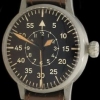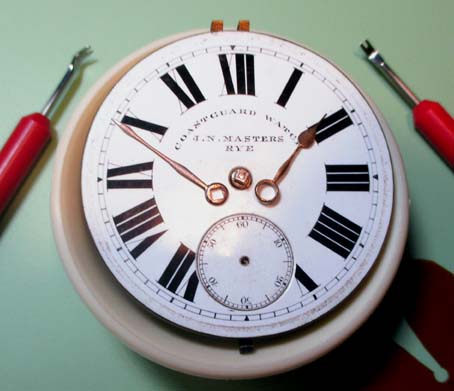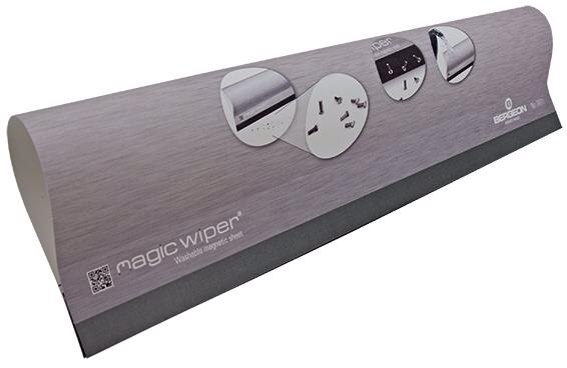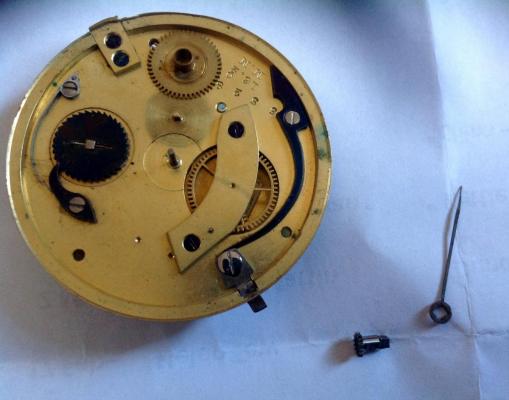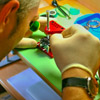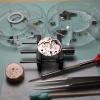Leaderboard
Popular Content
Showing content with the highest reputation on 12/21/15 in all areas
-
So I have two links with some additional information about the Accucells irst link it's at the bottom of the page. Second link is from the person who is selling these http://members.iinet.net.au/~fotoplot/accbat.htm.. http://www.ebay.com/itm/Accucell-1-Battery-For-Bulova-Accutron-Power-Cell-/231786028602 Then a slightly different link mercury batteries were just a problem for watches their problem for other things. So you read all the way through this or skim through it they do talk about the diodes it might be possible adapt one of their diodes release give you a clue as to what you're looking for. http://www.butkus.org/chinon/batt-adapt-us.pdf Then the original one of these my understanding was they use the resistor to drop the voltage later ones use a Diode. Then the link below is a picture of the internal construction. http://www.accutron214.com/accutronparts/pages/batteries.htm4 points
-
Hi guys, I finally got rid of the plasterers and got the carpets fitted (but not before they managed to chop through my internet cable) so thought I would post a quick update. I got the desk finished and am really happy with the results, it's super stable (even at raised height) and is plenty big enough for everything I need to do at it. The cupboard was an afterthought to keep my ultrasonic cleaner in along with the cleaning solutions and my timing machine. I will post some better pictures over the next few days with a more detailed overview but for now here's a couple of quick ones. Hope you like4 points
-
Many thanks gentlemen for the correct information. Here is the result. It was sold as a non-runner. After cleaning the balance it was running well for 36 hours on one wind but only the second hand moved. So the next step is to tighten the cannon pinion. Thanks George for the illustration of that step. A couple of taper pins only and I shall have the dial off, but that will await the morning as it is now time to sample a bottle of Cahors.2 points
-
DON'T USE ULTRASONIC CLEANING. Sorry for shouting Martin, but it will totally ruin the dial. I tried it once when I started off in horology and found that it severely damages the painted finish. If left long enough, it it will remove the paint altogether.2 points
-
I tend to stick with the same OS until forced to change. Each time I have changed I have had trouble with drivers and even had to get new hardware on occasion such as my scanner. Compatibility mode sometimes does not cut the mustard with some of my needs. I worked in IT for years before I retired and luckily have had no problems I could not fix but a lot of them were actually caused by updates to installed software and none moreso than Windows itself. At the minute i am still on Windows 7 which was a free upgrade when I bought my computer with Vista on it. I am comfortable with the OS and will stick until I have to upgrade. I am a great believer in "if it aint bust don't fix it" I suppose I am a creature of habit as I also drive my cars into the ground before buying a new one. :geek: :D Cheers, Vic2 points
-
I have used gold leaf for gilding hands and even the name of a sea-going boat. But do not use gold size, better to use two-component epoxy varnish and apply the leaf when the varnish layer become tacky. This recipe gives a very hard wearing coat of gold - the boat's name was still shining after 13 years at sea!2 points
-
1 point
-
Oh my! I'm going tweezer happy! I've ordered one of these, too. I'll report back with my preference when I have both. Cheers!1 point
-
Booze tweezers? For picking up those little airline bottles, maybe? Anyway, thanks! I snagged one for myself.1 point
-
Interesting, you're starting out almost the same way I did. I took apart an inexpensive quartz novelty watch (not as nice as your Invicta) to change the battery, the watch fell apart and the hands came off. I bought tools to replace the hands, then, before you know it, I'm servicing mechanical movements and having a great time! Well, there was stuff in between, but it has all been fun :-) Welcome!1 point
-
Agree with all of the above. You would be better off with a Swiss automatic as it will be much closer to what you would be likely to find in your Rolex, and the build quality will make it much easier to reassemble. Even then I would suggest starting off with a manual wind movement before progressing to an auto.1 point
-
I have been watching this post with interest as I serviced my Rolex 3135 approx a year ago. I spent a long,long time collecting all of the correct lubricants & tools. This includes a timegrapher which is essential with this grade of watch. The Rolex is not a standard build of watch i.e. to regulate you will need a microstella tool. The Rolex is unique as the regulation adjustments are made on the balance via tiny adjustment screws. These screws adjust both the beat & the regulation so attempting this task without a timegrapher would be foolish to say the least. Ps I was quoted by Rolex for a service £600 excluding parts.1 point
-
Hi Endeavor, First, Welcome to the forum. Now, the link is for Chinese copies of the Rolex. The movement inside most likely is completely different from what you have. IMHO, I would try my hand better at a Swiss made movement (they are closely related...sometimes). Hopefully, you could be started in one of those Swatch ETA 2840, 2842, 2846 which are inexpensive and fairly similar to the much expensive ETA 2824, 2836, etc. (some parts are interchangeable) At least, those will give you a feel for what you are dealing with. Then, of course, the Rolex movements may be somewhat different since they are, if I'm not mistaken, modified in house...but it would be most of the time based on some of those movements...or the other ones from the absorbed manufacturers now under the Swatch group and then nothing I've said applies. :) Hope this has confused you a little bit more. :) Cheers, Bob PS, And then there is the Chinese ETA clones and the Sellita movements and....oh, well!1 point
-
I've just checked, and pulled one from a movement I had lying around. The hand has a square hole in the middle. Pull it off the square, them pull off the hour hand. That leaves what looks like a canon pinion with a square. Remove the dial, and the hour wheel will slide over the pinion and square. You will now be able to pull off the pinion with the square. It is fitted on a taper, and requires a good pull or a bit of leverage. Here's a photo to help.1 point
-
Hi Roland, welcome to the forum. First of all I would strongly advise that you don't attempt to service your Rolex yourself until you have successfully stripped down and rebuilt a few other, less valuable movements. Probably the biggest challenge when you first start out working on watches is simply handling and manipulating the small parts without losing them. You are likely to encounter screws as small as 0.5mm (that's the screw driver size too not the thread size) so practice in handling parts on this scale is essential before tackling high value watches. The essential tools that you'll need are decent screw drivers, good tweezers, a movement holder, and a loupe. You will also need a case wrench that will fit your Rolex when you come to tackle that. A timegrapher is not essential (at least not to start with) but is nice to have, however you do not need to spend a fortune. There are some very good computer programmes out there which are available for free (look for Watch-O-Scope or Biburo to name a couple). New main springs don't require a winder as they are supplied ready wound in a washer, you just push them into the barrel. Lubricants are expensive though, even for the 2ml pack sizes, but they will last you for a lot of watches. The most important attribute though is patience, you will need that in abundance. You will certainly get all the advice you need here.1 point
-
may be you are right, i was wrong about cyma, the escape wheel bridge is different. I have also the Complete watch guide showing similar movement but with 17j 3adj and micro metric regulator, There is thread about similar movement here : http://mb.nawcc.org/showthread.php?95640-Moon-pocket-watch-would-like-additional-information1 point
-
Might be helpful: http://amateurwatchmaking.com/2014/06/03/revue-30-19-linge-syren-dennison-star-ww1-pocket-watch/1 point
-
Hi, I'm am a newbie in watch repair and have just completed some informal lessons about disassembly, assembly and lubrication of a couple of mechanical ETA movements. Hoping to begin lessons on regulating movements soon. Also, big thanks to Mark and his youtube instructional videos which helped me a ton in having an idea of how to handle a movement even before I started with the lessons. It gave me a sense of "preparedness" and confidence. I'm eager to learn from the experts here and glad to have a forum like this. Cheers! lastshotkid Sent from my iPhone using Tapatalk1 point
-
Been on this forum a while now and made some good friends from all over the world. I presume you have seen Marks Videos, if not start working your way through them. Cheers, Vic1 point
-
I don,t know I just found this on the net; It looks the same !!!! http://mb.nawcc.org/showthread.php?106445-Need-help-identifying-an-antique-pocket-watch-Swiss-Made Sourcing pocket watch parts is difficult & the spring fitted is most likely not correct. The GR number I quoted are in the GR book for watches of 19". If it is the only fault I would fit a new mainspring & just service the watch. Here is a link to workout the length of spring you will require: http://www.nawcc-index.net/CalcMainspringLength.php There normally is a string off numbers somewhere either on the watch or case which will guide you to the year of manufacture.1 point
-
A reminder when measuring coil resistance of a coil that is in an electric watch unless you can isolate the coil you need a special meter. The meter needs to supply a very low voltage otherwise you risk turning on the circuit and getting a false reading. The coil resistance of this watch is supposed to be between 2K and 2.2 K ohms. Then there is the other problem this watch was designed to run on a Mercury battery 1.34 V and the modern silver cell at 1.55 can cause problems in some of these watches. I've attached the Omega PDF that explains this. John No 23 Modification of electronic module_Calibre 1310 E_2004_.pdf1 point

